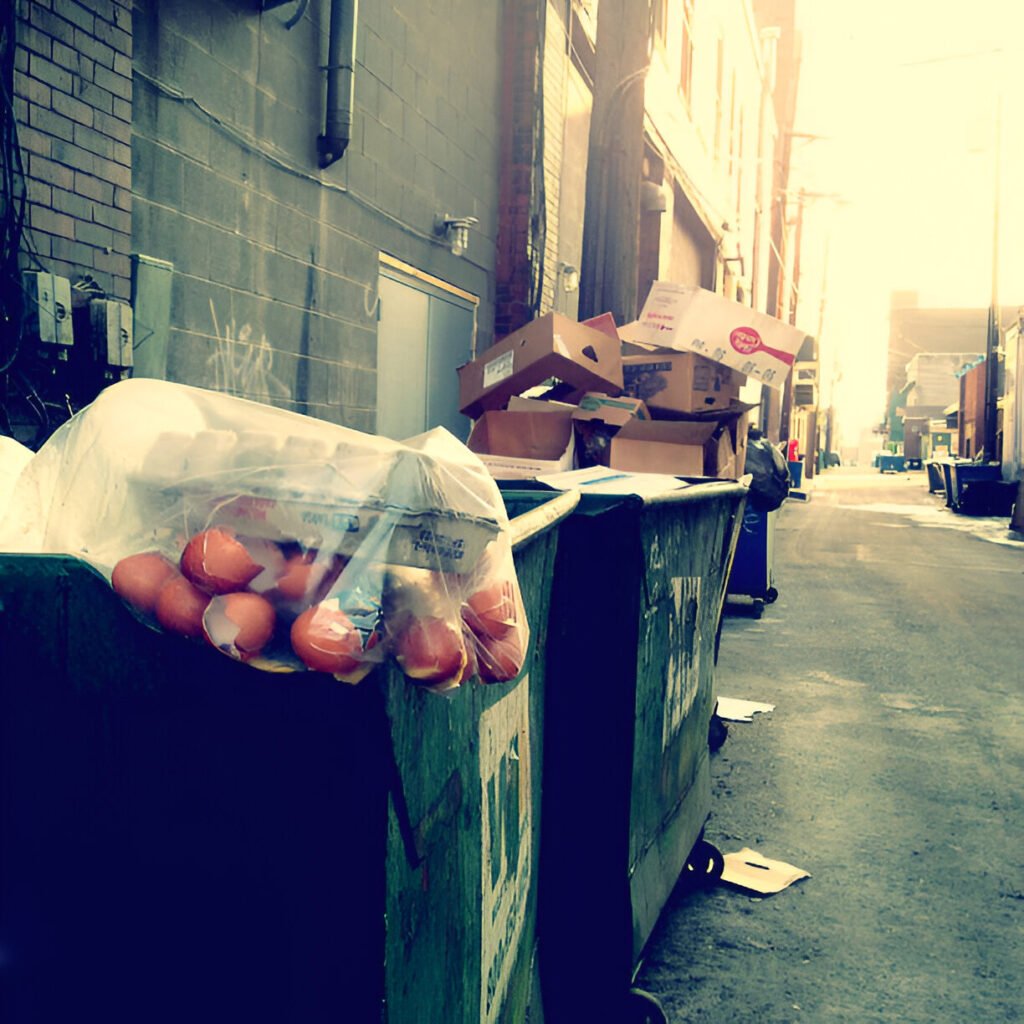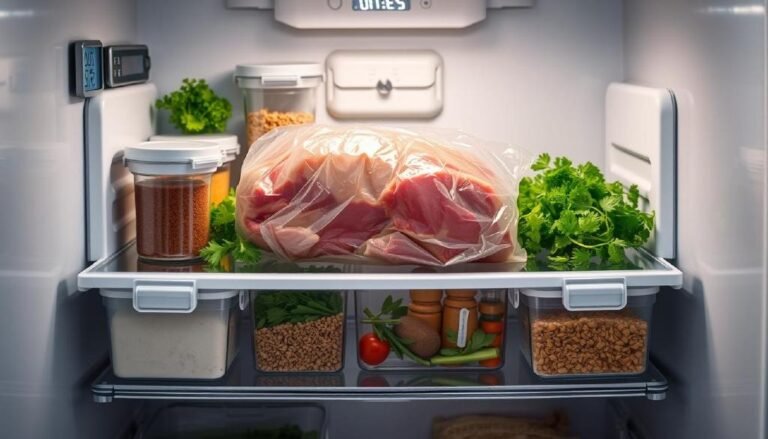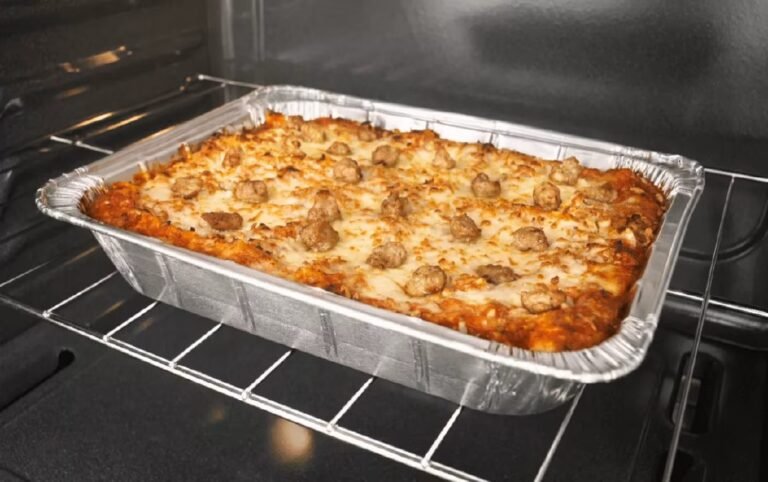America’s Food Waste Crisis: 25 Stats That Demand Immediate Action
The United States throws away a huge amount of food. This waste equals 130 billion meals and costs over $408 billion. Despite efforts to save 3.6 billion pounds of food each year, the country still wastes a staggering 119 billion pounds.
Keep reading to learn about food waste in America. Here are some key stats and current details.
Food Waste in America Quick Summary
- The waste collection services industry is expected to grow by 1.1 percent each year from 2018 to 2023. By 2023, its market size will be at least $73.7 billion.
- Each American throws away about 219 pounds of food. That’s over 650 average-sized apples. This waste makes up 22 percent of Municipal Solid Waste (MSW) in US landfills.
- Research shows that people with healthier diets, rich in fruits and vegetables, often waste more food. This is because they tend to throw out these items more often.
- According to Waste Not, approximately 40% of food is wasted annually in Arizona, while almost one million Arizonians suffer hunger.
- Approximately $161 billion to $218 billion of food is discarded annually in the US.
- An average American family with at least four members wastes at least $1,500 – $1,600 in food yearly.
- America ranks third in the top 10 countries that generate the most food waste, discarding more than 19 million tons of food every year.
- Michigan has the highest amount of waste thrown out in landfills, with at least 66.5 tons of food waste per person.
- Roughly 35% or 93 million kilograms (204 million pounds) of edible turkey meat end up in landfills.
- Food waste and yard trimmings make up more than a third (33.7%) of US garbage.
- Shrink-wrapping food produce helps to reduce food waste by increasing its shelf life.
- 43 percent or about 21 million tons (42 billion pounds) of food is wasted in homes, almost similar to the amount of food wasted in restaurants and grocery stores.
Top 25 Food Waste in the US Facts & Statistics

1. In the United States, food waste is estimated at 30-40 percent of the food supply.
The United States wastes 40 million to 80 billion pounds of food each year. This amounts to about 30 to 40 percent of its total food supply.
Each American wastes about 219 pounds (ca. 99 kg) or more than 650 average-sized apples, taking up 22 percent of municipal solid waste (MSW) in the US landfills. [1]
2. Americans waste 150,000 tons of food daily, equal to a pound per person.
About 150,000 tons of food is thrown out in US households each day, equivalent to a pound of food waste per American.
Research shows that people who eat a lot of fruits and vegetables often waste more food. This is because these foods are thrown away more often. [2]
High-quality diets were associated with increased food waste and were found to use up more water and pesticides. [3]
3. Arizona is the US state that has the most food waste.
According to Feeding America, one (1) in nine (9) Arizonians face hunger. [4]
However, Waste Not reported that at least 40% of food is wasted in Arizona every year, while almost one million Arizonians suffer hunger.
Moreover, according to Jeff Herman, a spokesperson of Imperial Western Products, the lack of consciousness about food waste sends more than 78% of food to the Arizona landfill. [5]
Top 15 States With The Most Food Waste (2022)
| State | Overall Score | Food Wasted Rank | Repurposed Food Rank | Mitigation Efforts Rank |
| Arizona | 82.91 | 4 | 1 | 17 |
| North Dakota | 78.13 | 12 | 3 | 8 |
| Hawaii | 77.54 | 16 | 2 | 12 |
| Nevada | 77.12 | 11 | 7 | 7 |
| Oklahoma | 76.68 | 15 | 6 | 6 |
| West Virginia | 75.79 | 19 | 8 | 4 |
| Wisconsin | 75.73 | 5 | 4 | 24 |
| Georgia | 74.9 | 6 | 13 | 20 |
| Montana | 74.33 | 25 | 9 | 10 |
| South Dakota | 74 | 33 | 10 | 1 |
*Disclaimer: All 50 states were ranked, but we only reflected the top 10 states with the highest number of food waste.
4. Annual food waste in the United States is worth at least $161 billion.
Approximately $161 billion to $218 billion of food is discarded annually in the US.
Thus, an average American family with at least four members wastes at least $1,500 – $1,600 in food yearly.
One family’s food waste, when multiplied by the 18 years a child usually lives at home, could pay for at least a year of college tuition in the U.S.
5. America ranks 3rd in food waste, next to China and India.
America ranks third in the top 10 countries that generate the most food waste, discarding more than 19 million tons of food every year.
China bagged first place with 91 million tons and India with more than 68 million tons of food waste. [6]
Top 10 Countries That Generate The Most Food Waste (2023)
| Country | Gross Amount Of Food Waste | Population | Rank |
| China | 91 million tons | 1,425,671,352 | 1 |
| India | 68 million tons | 1,428,627,663 | 2 |
| United States | 19 million tons | 339,996,563 | 3 |
| Japan | 8 million tons | 123,294,513 | 4 |
| Germany | 6 million tons | 83,294,633 | 5 |
| France | 5 million tons | 64,756,584 | 6 |
| United Kingdom | 5 million tons | 67,736,802 | 7 |
| Russia | 4 million tons | 144,444,359 | 8 |
| Spain | 3 million tons | 47,519,628 | 9 |
| Australia | 2 million tons | 26,439,111 | 10 |
6. The waste collection services industry in America had a market size of 68 billion US dollars in 2022.
America’s waste collection services industry grew by 2.3% from 2017 to 2022. Now, the industry has a whopping market size of $68 billion. [7]
The waste collection services industry is expected to grow by 1.1 percent each year from 2018 to 2023. By 2023, the market size will reach at least $73.7 billion. [8]
7. More than 80 percent of Americans throw perfectly good food because they misunderstand expiration labels.
Due to misinterpreting expiration labels, more than 80 percent of Americans discard good food, increasing the size of US landfills.
Most often, labels such as “sell by” and “best if used by” are misunderstood, making most consumers think they equate to being expired.
Research in the UK shows that if food labels were federally regulated and standardized, household food waste could drop by at least 20%.
8. Half a pound of food is wasted per meal in restaurants.

Reports say that restaurants waste at least half a pound of food per meal. This waste comes from both customers’ plates and the kitchen.
Shockingly, at least 85% of food is thrown out, while only a small percentage is donated or recycled.
The National Restaurant Association [9] found that restaurants lose about four to ten percent of their food. This loss lowers their costs by at least two to six percent.
9. About 21-33% of water across US farms is wasted.
When food is unconsumed and ends up in a landfill, the amount of water to produce it is wasted, too.
About 21 to 33 percent of water on US farms is wasted each year. Agriculture uses 80 percent of all water consumed in the country.
10. Michigan leads the US with at least 66.5 tons of waste in landfills per person.
Michigan has the highest amount of waste thrown out in landfills, with at least 66.5 tons of food waste per person. Indiana follows it with 59.9 tons and Pennsylvania with 57.4 tons per person.
Top 10 States With The Highest Food Waste In Landfills Per Person (2022)
| State | Tons of Waste in Landfills per Person |
| Michigan | 66.5 tons |
| Indiana | 59.9 tons |
| Pennsylvania | 57.4 tons |
| Illinois | 54.8 tons |
| Ohio | 52.4 tons |
| Wisconsin | 51.8 tons |
| California | 50.4 tons |
| Nevada | 48.4 tons |
| Colorado | 47 tons |
| Kentucky | 46.8 tons |
11. Food waste takes up more space in US landfills than anything else.
According to Food and Drug Administration, EPA estimates that at least 24 percent of municipal solid waste is food waste. [10]
12. 35% of edible turkey ends up in trash bins on Thanksgiving.
Roughly 35% or 93 million kilograms (204 million pounds) of edible turkey meat end up in landfills.
The US Department of Agriculture [11] reports that food waste has risen by at least 25 percent. This increase is due to unsold items at supermarkets and leftovers that go uneaten during the holiday season.
| Check out: Best Trends In The Food & Beverage Industry |
13. Each year, the average American throws away nearly 100 kilograms (219 pounds) of food.
Reports say that the average American discards nearly 219 pounds or 100 kilograms of food annually. This amount of food waste is equivalent to 120 billion meals (at least $408 billion), almost 40% of America’s food supply [12], or around 365 million pounds of food being wasted per day. [13]
14. The United States generates approximately 119 million tons (238 billion pounds) of food waste, the equivalent of over 528,000 Statue of Liberties.
In 2018, about 206 billion pounds or 103 million tons of food waste was generated in the US, equivalent to over 450,000 Statue of Liberties.
America’s food waste tripled in just five decades, estimated to be 30 to 40 percent of its total food supply. Now, the US generates roughly 119 million tons (238 billion pounds) of food waste.
15. The average American family of four throws out $1,500 worth of food per year.
At least $1,500 – $1,600 worth of food is wasted annually by the average American family of four. It’s equivalent to 1,250 calories per person per day. This estimate doesn’t even include the recent food price inflation.
Unfortunately, at least 35% of the total food supply, or 80.6 million tons, is wasted across all sectors. [14]
16. The total number of food-insecure Americans is expected to rise up to more than 50 million in 2022.
Only 37 million people and 11 children across the US had food insecurity before the pandemic. However, it’s expected to rise up to more than 50 million by the end of 2022.
According to Feeding America, one in six Americans has food insecurity, which can rise further in the coming years.
17. Up to 40 percent of the food in America is never eaten.
At least 35 – 40 percent of the total food supply in America is never eaten, which means that 40 percent of what every American buys ends up in the garbage.
The FDA states that food is the biggest waste in municipal landfills. This wasted food could have fed families in need. [15]
18. Food waste and yard trimmings make up more than a third (33.7%) of US garbage.
At least 33.7 percent, or more than a third of the US landfill, is comprised of yard trimmings and food waste. Some of these wastes are organic, and they can be easily composted.
The US doesn’t have enough infrastructure to compost and recycle materials like paper and paperboard. These make up at least 23.1 percent, or about a quarter, of the trash in America.
19. According to the EPA, the average American person will produce about 5.91 pounds of trash, with about 1.51 pounds being recycled.
EPA claims that the average American produces roughly 5.91 pounds of trash, but only 4.40 pounds is a person’s average daily waste. And only 1.51 pounds of the trash is recycled.
An average American throws out approximately 220.96 pounds of food waste in a year.
If Americans produce about 254 million tons of trash each year and only 34.3 percent is recycled, then the average American makes at least 1,361.4 pounds of trash. That’s roughly the weight of a grizzly bear!
20. America is home to only 4% of the world’s population but is responsible for 12% of the planet’s trash.

America may only be just about 4 percent of the world’s population, but it makes up at least 12 percent of the world’s trash.
Fortunately, the US decided to change this unfortunate stance. The US decided to embrace the concept of zero waste. Many US states, including New York, San Diego, and San Francisco, chose to join the war. They aim to end the trash-to-landfill cycle by 2040 or even sooner. [16]
| Read: 40+ Shocking Fast Food Statistics | US & Worldwide Data |
21. Food Waste in America is equivalent to Greenhouse emissions of 37 million cars.
Food waste creates methane, a greenhouse gas 28 to 36 times stronger than carbon dioxide. This makes landfills the third biggest source of methane emissions.
With 30-40 percent of food waste in landfills, America generates greenhouse emissions equivalent to at least 42 coal-fired power plants or 37 million cars.
22. Shrink-wrapping food produce helps to reduce food waste by increasing its shelf life.
It’s hard to believe that plastic can help fight waste. Many eco-conscious people see plastic as harmful to the environment.
Greenbiz states that shrink-wrapping food helps cut waste. It stops spoilage and extends shelf life. [17]
Greenbiz reported that a study found the environmental benefit of reducing food waste from plastic-wrapped cucumbers is 4.9 times greater than the negative impact of the packaging. [18]
23. The size of your fridge can impact the amount of food you waste.
As refrigerators get bigger, people buy more food. [19] The larger your fridge is, the more amount of food you tend to waste.
According to Evans, the fridge serves as the coffin of decay that carries disregarded food to the trash bin (Evans 2014, 69).
When the fridge is too big, the food stored in it tends to get lost and forgotten. When food “just sits in the fridge,” it only becomes discoverable when it’s past its due date. [20]
24. The most wasted food type in the US is bread, with 38% of all grain products lost every year across the country.
Over 240 million slices of bread are wasted, making it the most wasted food type in the US.
In the US, about 38 percent of grain products are lost. Milk follows, with nearly 20 percent of all produced milk wasted.
Top 5 Most Wasted Food In The US
| Food Type | How Much Is Wasted Per Year | Rank |
| Bread | Over 240 million slices | 1 |
| Milk | Around 5.9 million glasses | 2 |
| Potatoes | 5.8 million pieces | 3 |
| Cheese | 3.1 million slices per day | 4 |
| Apples | 1.3 million pieces | 5 |
25. Around 43% of food waste in the US comes from homes.
Nearly half (43 percent) of food, or about 21 million tons (42 billion pounds), is wasted in homes. This is almost the same as what restaurants and grocery stores waste.
Research shows that household makeup matters. The number of people and kids in a home greatly affects how much food is wasted. On average, households with more occupants, including children, generate more food waste. [21]
FAQs onf America’s Food Waste Crisis
Where does the US rank in food waste?
According to Forbes, the US ranks third in food waste, throwing away an estimated 19.4 million tons of food every year, where China came first, and India came second.
Why is food waste a problem in the US?
Food waste is a problem in the US because food waste emits methane, which is a powerful greenhouse gas that affects climate change. Food waste also wastes resources such as water, land, labor, energy, and other inputs for producing, processing, transporting, preparing, storing, and disposing discarded food.
Who manages food waste in the US?
The US Environmental Protection Agency (EPA), the US Department of Agriculture (USDA), and the US Food and Drug Administration (FDA) manage food waste in the US.
They signed a joint agency agreement in 2018, renewed in 2020, aiming to reduce food loss and waste.
Does the US have a goal to reduce food loss and waste?
Yes, the US has a goal to reduce food loss and waste. EPA and USDA announced the US 2030 Food Loss and Waste Reduction goal, seeking to cut food loss and waste in half by 2030. The federal government, led by EPA, FDA, and USDA, aims to reduce climate and environmental impacts associated with food loss and waste, improve food security, and save money for families and businesses.
In Summary
Food waste in the United States is a $408 major problem. It is equivalent to 130 billion meals, which could have been a huge help in combating hunger.
Food waste also helps mitigate climate change by emitting greenhouse gas 28 to 36 times more potent carbon dioxide than most vehicles emit. It also affects the supply chain, greatly affecting families, restaurants, groceries, and other businesses.
Unfortunately, the amount of food waste in the US increased, so the waste collection services industry market size worth will be more likely to achieve the projected 1.1 percent increase in 2023, which is worth $73.7 billion.
References:
- https://www.usda.gov/foodwaste/faqs
- https://www.theguardian.com/environment/2018/apr/18/americans-waste-food-fruit-vegetables-study
- https://www.newsweek.com/americans-waste-150000-tons-food-every-day-thats-pound-person-892411
- https://agriculture.az.gov/news/no-one-says-no-food-waste
- https://www.tastingtable.com/754095/study-reveals-the-state-that-wastes-the-most-food/
- https://worldpopulationreview.com/country-rankings/food-waste-by-country
- https://www.statista.com/statistics/1099882/waste-collection-services-industry-key-figures-us/#
- https://www.ibisworld.com/industry-statistics/market-size/waste-collection-services-united-states/
- https://restaurant.org/
- https://www.fda.gov/food/consumers/food-loss-and-waste#
- https://www.usda.gov/
- https://www.feedingamerica.org/our-work/reduce-food-waste
- https://sites.psu.edu/cowancivicissue/2019/03/25/food-waste/
- https://www.fastcompany.com/90825190/americans-throw-out-32-of-the-food-they-buy-heres-how-to-avoid-so-much-waste
- https://www.fda.gov/food/consumers/food-loss-and-waste
- https://www.nrdc.org/onearth/united-states-most-wasteful-country-world
- https://www.tandfonline.com/doi/full/10.1080/07409710.2022.2089828
- https://www.greenbiz.com/article/beating-food-waste-needs-plastic-question-where-and-when
- https://sites.psu.edu/cowancivicissue/2019/03/25/food-waste/
- https://www.tandfonline.com/doi/full/10.1080/07409710.2022.2089828
- https://www.ncbi.nlm.nih.gov/pmc/articles/PMC9192138/
- https://www.forbes.com/sites/niallmccarthy/2021/03/05/the-enormous-scale-of-global-food-waste-infographic/
- https://www.usda.gov/foodlossandwaste/why#
- https://www.fda.gov/food/consumers/food-loss-and-waste
- https://www.epa.gov/sustainable-management-food/united-states-2030-food-loss-and-waste-reduction-goal#

Kathy is a restaurateur, artist, and blogger. After spending more than 10 years in the restaurant industry, she has decided to go digital and share her expertise and experience online.







